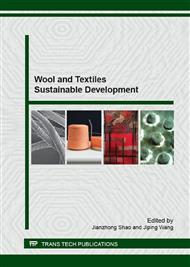[1]
Datye, Keshav V. AN fiber variants, Synthet. Fibers (Oct/Dec), 5-14 (1997).
Google Scholar
[2]
Kawata, T., and Kanebo, Gohsen, First Permanently An-tibacterial and Deodorant Fibers, Chem. Fibers 1nt. 48, 38-43 (1998).
Google Scholar
[3]
Ozawa. Toshio, Shiotani, Tsutomu, Antibacterial fiber products and safe antibacterial treatments for use in their manufacture, JP 08/113874, May 7, (1996).
Google Scholar
[4]
Stevanato, R., and Tedesco, R., New Antibacterial Acrvlic Fiber, Chem. Fibers Int. 48: 480-485 (1998).
Google Scholar
[5]
Yamaguchi, Yasuhide. and Yamazaki, Massatoshi, Anti-bacterial Deodorization Materials for Bad Smell Gases. JP 08/224289, Sep 3, (1996).
Google Scholar
[6]
XWu, Yue, Chi, Yanbo, Nie, Jiaxiang, Yu, Aiping, and Chen, Xuehua, Preparation and Application of Novel Fab-ric Finishing Agent Containing Nano ATO (in Chinese), J. Function. Polyhn. 15 (1): 43-47 (2002).
Google Scholar
[7]
DONG WANG, YAO LmI YAN ZHAO, AND LIXIA Gu, Polyacrylonitrile Fibers Modified by Nano-Antimony-Doped Tin Oxide Particles, Textile Res. J. 74(12), 1060-1065 (2004).
DOI: 10.1177/004051750407401206
Google Scholar
[8]
Da-Xiong Wu, Jun-Yan Hu, Shu-Xiao Wang. Novel infrared radiation properties of cotton fabric coated with nano Zn/ZnO particles, Colloids and Surfaces A: Physicochem. Eng. Aspects 300: 140–144 (2007).
DOI: 10.1016/j.colsurfa.2007.01.001
Google Scholar
[9]
Roya Dastjerdi, Majid Montazera, Shadi Shahsavan, A new method to stabilize nanoparticles on textile surfaces, Colloids and Surfaces A: Physicochem. Eng. Aspects 34: 202–210 (2009).
DOI: 10.1016/j.colsurfa.2009.05.007
Google Scholar
[10]
WALID A. DAOUD and JOHN H. XIN, Low Temperature Sol-Gel Processed Photocatalytic Titania Coating, Journal of Sol-Gel Science and Technology 29: 25–29(2004).
DOI: 10.1023/b:jsst.0000016134.19752.b4
Google Scholar
[11]
A YADAV, VIRENDRA PRASAD, A A KATHE, SHEELA et al. , Functional finishing in cotton fabrics using zinc oxide nanoparticles , Bull. Mater. Sci., 29(6) : 641–645.
DOI: 10.1007/s12034-006-0017-y
Google Scholar
[12]
C. Yang ,P. Gao ,B. Xu , Investigations of a controllable nanoscale coating on natural fiber system: effects of charge and bonding on the mechanical properties of textiles , J Mater Sci 44: 469–476(2009).
DOI: 10.1007/s10853-008-3094-z
Google Scholar
[13]
Ronghua Wang, John H. Xin , Xiao Ming Tao, Walid A. Daoud,ZnO Nanorods grown on cotton fabrics at low temperature,Chemical Physics Letters 398: 250–255 (2004).
DOI: 10.1016/j.cplett.2004.09.077
Google Scholar
[14]
SHI Qiu-ping,KAN Hong,MAO Zhi- ping. Influence of hydrothermal condition to Zn O in-situ growing on cotton fabric, Journal Of Donghua University (Natural Science), 33(6): 711-766(2007).
Google Scholar
[15]
Sunandan Baruah, Chanchana Thanachayanont and Joydeep Dutta. Growth of ZnO nanowires on nonwoven polyethylene fibers, Sci. Technol. Adv. Mater. 9: 1-8 (2008).
Google Scholar
[16]
DONG Weiguo, XU Jing, HUANG Junpeng ,Pore structure characterization of cotton fiberby nitrogen adsorption ,Journal of Textile Research ,28(6): 5-7(2007).
Google Scholar
[17]
MA Zeng-xian , YAN Ping-ke, MA Zhi-jun , HAN Yue-xin , YUAN Zhi-tao . Formation Mechanism of Nano- ZnO Prepared by Using One-step Method, JOURNAL OF SYNTHETIC CRYSTAL, 37 (2): 305-309 (2008).
Google Scholar
[18]
BarataMAB, NevesMC, Pascoal Neto C, Trindade T , Growth of BiVO4 particles in cellulosic fibres by in situ reaction. Dyes Pigments, 65: 125–127 (2005).
DOI: 10.1016/j.dyepig.2004.07.005
Google Scholar


